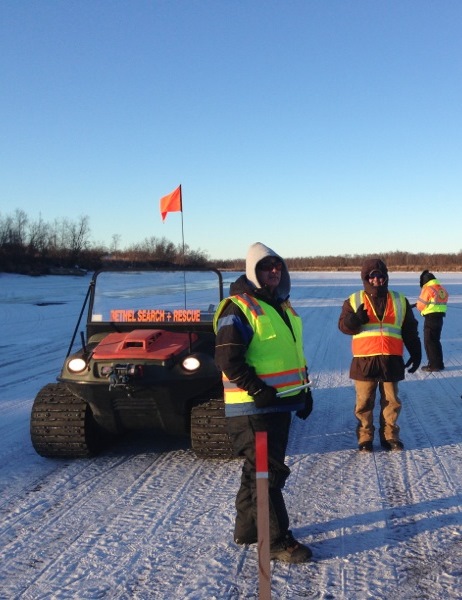On December 8th, a 3 man BSAR team traveled 90 miles upstream of Bethel by snowmachine to assess conditions for winter travel at the ice jam that occurred at Coffee’s Bend during the November break up of the Middle Kuskokwim.
They were only able to view the very lower end of the jam that extends several miles upstream. Earlier aerial reconnaissance showed that the worst section of this jam is about a mile further up.
This entire stretch of the Kuskokwim is impassable by motor vehicle at this time. Even walking through it is difficult.

The end of the line: from this point right at Coffee’s old fish camp there is no more beach and the River is too rough to drive on
It will take a great deal of snow, wind and/or rain to improve this area enough for safe travel. Holiday travel from the Lower River to Kalskag may need to use the tundra, back sloughs, and old portages. One tough, brave person has already made the trip using these alternatives – taking two and a half days to go from Bethel to Kalskag. We will continue to monitor conditions in this area throughout the winter and into the spring to see how it affects the 2015 break up.

L-R: BSAR Members Manno Rodgers & Randy Turner make the long trip from Bethel to assess the jam at Coffee’s Bend below Kalskag
Additional Observations Made on the Trip:
After two days of strong north winds – there is very little snow left out there. All River travel was on glare ice. The River around Akiak is sandy with blowing sand. The main trail to Akiak uses the Kuskokwim River from Akiachak. Kuskokquak Slough has two large open holes. One is marked – one is not. There is no main trail to Tuluksak on the River at this time. There is a very large unmarked open hole above Mike Napoka’s Island about halfway between Akiak and Tuluksak. Travel to Tuluksak is by back trail from either Akiachak or Akiak.
Above Tuluksak shell ice from last month’s high water is present on all the sandbars and beaches. This shell ice ranges from 1 to 2 feet or more deep.
While most of the small open holes above Tuluksak have frozen over there are still several large ones in 40 miles leading up to the jam at Coffee’s.

Large lip at the south end of an open hole at the upper end of Nelson Island above Tuluksak. This lip is over 2 feet tall from the strong north wind we’ve been having the past couple of days
That’s the report for December 8, 2014
Thank you & safe travel from BSAR
*Please note: this report is for informational purposes only and is not an advisory that it is safe to travel







































